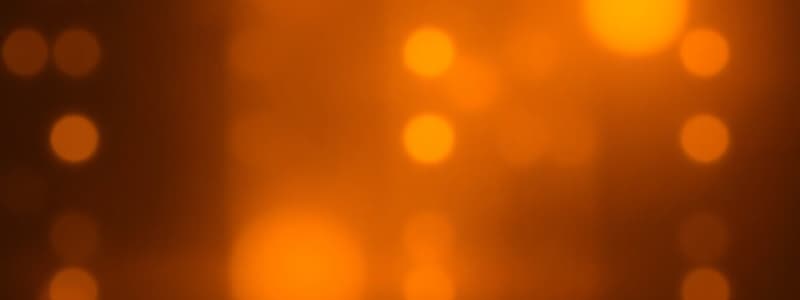Podcast
Questions and Answers
What happens when light falls on a transparent object?
What happens when light falls on a transparent object?
- The light passes through the object. (correct)
- The light is reflected by the object.
- The light is absorbed by the object.
- The light is refracted by the object.
What happens when light falls on an opaque object?
What happens when light falls on an opaque object?
- The light is reflected by the object.
- The light is refracted by the object.
- The light is absorbed by the object. (correct)
- The light passes through the object.
What happens when light falls on a mirror?
What happens when light falls on a mirror?
- The light is absorbed by the mirror.
- The light is transmitted through the mirror.
- The light is reflected by the mirror. (correct)
- The light is diffracted by the mirror.
What happens when light falls on a glass object?
What happens when light falls on a glass object?
How does light travel?
How does light travel?
Which of the following is an example of a non-luminous body?
Which of the following is an example of a non-luminous body?
What is the primary source of light for the moon?
What is the primary source of light for the moon?
Which statement best describes how we see a non-luminous body like an armchair?
Which statement best describes how we see a non-luminous body like an armchair?
What is the essential characteristic that allows light to travel through empty space?
What is the essential characteristic that allows light to travel through empty space?
How does light travel from the sun to the Earth?
How does light travel from the sun to the Earth?
Flashcards
Light
Light
A form of energy that allows us to see objects.
Illuminating Light Sources
Illuminating Light Sources
Bodies that produce visible light, like the sun or bulbs.
Non-Illuminating Objects
Non-Illuminating Objects
Objects that do not produce light but can reflect it.
Propagation of Light
Propagation of Light
Signup and view all the flashcards
Luminous Bodies
Luminous Bodies
Signup and view all the flashcards
Light propagation
Light propagation
Signup and view all the flashcards
Transmitted light
Transmitted light
Signup and view all the flashcards
Absorbed light
Absorbed light
Signup and view all the flashcards
Reflected light
Reflected light
Signup and view all the flashcards
Non-light-source visibility
Non-light-source visibility
Signup and view all the flashcards
Study Notes
Light and its Spread
- Light is critical in observing things and creating shadows
- Light is a form of energy transfer
- Light sources are classified as illuminating or non-illuminating
- Illuminating bodies produce light
- Non-illuminating bodies reflect light
- Light travels in a straight line
- Light from a lamp spreads in a straight line
- We see non-light-producing objects because they reflect light onto our eyes
Studying That Suits You
Use AI to generate personalized quizzes and flashcards to suit your learning preferences.




